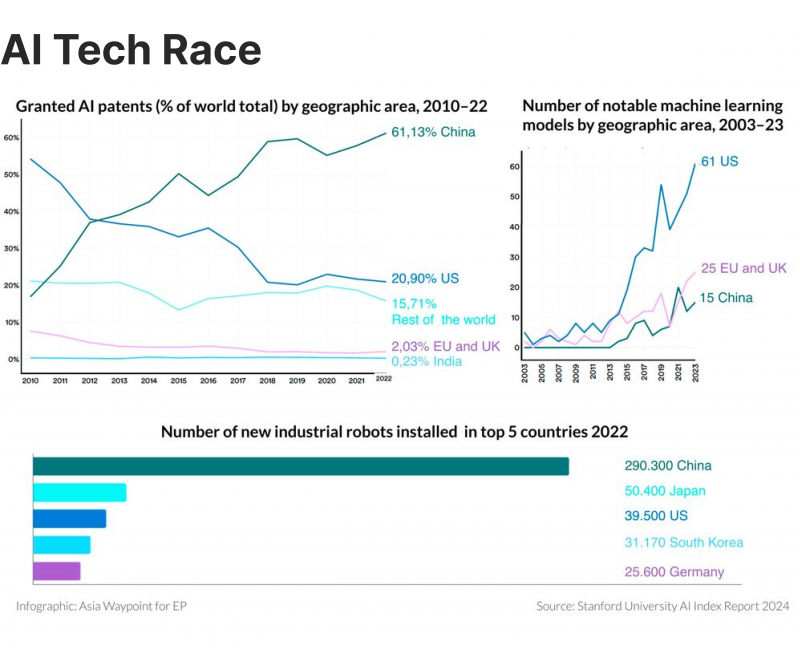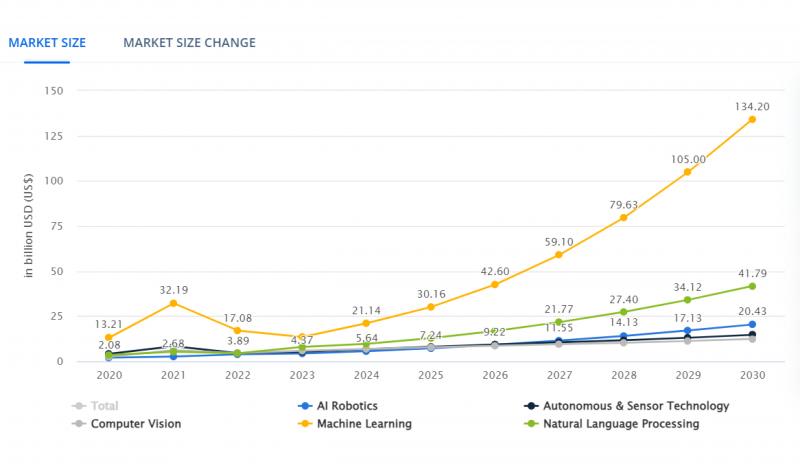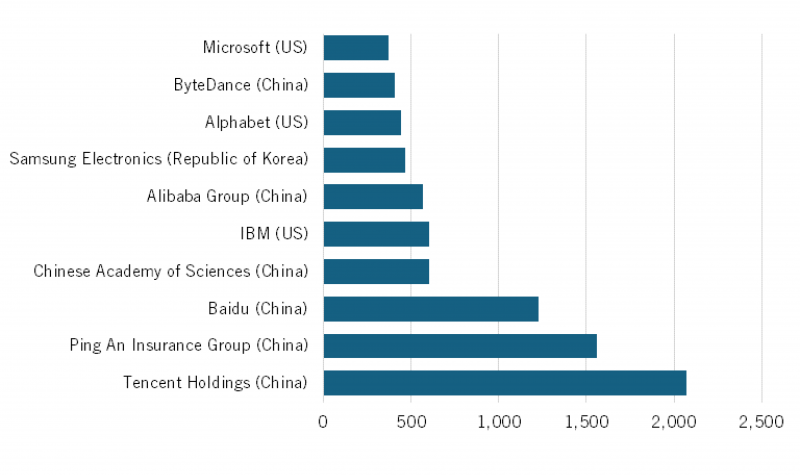AI Regulation News – How Does The Global Tech Race Look Like?

The introduction and development of AI are sending shockwaves around the world, founding cutting-edge inventions in technology, finance, and manufacturing.
One of the evident footmarks of AI is the Tesla “We, Robot” event, which introduced superior innovations powered by machine learning and artificial intelligence.
At the same time, the SEC AI regulations are entering their final phase, and policymakers are debating the necessity of regulating these advancements. Many of these calls stem from economic leadership and minimising human damage.
Let’s review the AI regulation news across the globe and assess the potential benefits and challenges of controlling these technologies.
AI Trends and Rules Overview

The global AI market size is estimated at $184 billion in 2024, which is expected to increase massively by the end of the decade. Statista estimates that a whopping 28% CAGR (2024-2030) will potentially expand the market capitalisation to over $826 in 2030.
Much of today’s growth is attributed to machine learning and natural language processing, which might triple their sizes in the coming years.

However, there is an ethical debate around the development of AI-powered machines and products. Many expressed their concerns about robotic prevalence over humanity. However, policymakers look at it from an economic perspective, attempting to boost local AI innovations and lead the market as much as possible.
The US has restricted the exporting of high-performing processing chips to China because these products are used to embed AI technology into automobiles, healthcare, retail and robotics. Outbound investments in AI are said to damage national tech developments and, therefore, market leadership.
Generative AI is one of the most advanced technologies that use natural language processing (NLP) to generate human-like output. This feature uses text or voice input and provides results within seconds, such as designing an image, scheduling meetings, brainstorming ideas, etc.
Apple, Amazon, and Nvidia are leading firms that adopt Generative AI into their smartphone software, customer service, and self-driving cars.
Explore Deeper Industry Insights
Learn from experts shaping the future of financial services — get the latest strategies and trends.
Key Concerns with AI Developments
Many question why AI should not be regulated and why we need limitations on artificial intelligence. It is a combination of factors that drive these concerns.
- Ethical Risk: Manipulated datasets can cause AI systems to make unfair decisions, especially in hiring and law enforcement.
- Security Issues: AI-powered machines can perpetuate targeted cyberattacks and generate misinformation.
- Privacy Concerns: Having robots in households and companies imposes several personal and corporate privacy risks.
- Control Dilemma: Autonomous software can compromise human decisions and judgement, especially in the military and finance.
- Job Replacement: The ability to perform complex tasks at a higher speed than humans threatens job and income stability.
AI Regulation News Around The World
Controlling the advancement of artificial intelligence is necessary to avoid having a technology bubble or catastrophic outcomes. Some argue that the ongoing boom can have a similar effect to the dot-com bubble. Let’s review some of these efforts curbing this growth.
AI Regulation in the US
The United States is currently the largest AI developer in the world, with a massive market size estimated at $50 billion, occupying 27% of the entire industry. However, the rising trends in China are major concerns for US lawmakers.

Last year, President Joe Biden signed a decree to ban investment in China pertaining to artificial intelligence, quantum computing, semiconductors and microelectronics.
On a national level, the United States does not have a centralised body to regulate this industry. It utilises a decentralised management system, where each sector evaluates the application of AI. For example, the National Highway Traffic Safety Administration ensures the correct implementation of self-driving vehicles.
The only exception relates to national security, such as institutional data collection, autonomous machines and tech manufacturing.
AI Laws in China
China is the second-largest economy and the most evident US competitor in AI technology. Its current market size is estimated to be $34 billion, which is 18% of the global capitalisation.
It has some of the largest development institutions and the world’s most issued AI patents. In fact, of the top ten patent owners, six are Chinese corporations.

China follows a centralised approach to regulations, offering a comprehensive regulatory framework encompassing all AI and cyber applications and developments.
These rules focus on national security, data protection and government monitoring. Several reforms were created for this purpose, such as the Personal Information Protection Law, Cybersecurity Law and the New Generation AI Development Plan.
The guidelines promote innovation with strict control over some aspects, especially surveillance, data collection and military applications.
EU AI Regulations
The EU AI Act drives the regulatory framework in the European Union, which focuses on the ethical use of artificial intelligence technology. The draft was voted for in March 2024 and is expected to be finalised this year, with full application in 2026.
The EU AI regulations work similarly to the GDPR standards concerning the data collection, processing and usage by AI systems. The law could restrict any uncontrollable function by autonomous machines and promote the healthy use of consumer data.
However, too many restrictions at this stage are deemed excessive and might hinder the region’s advancement into AI and machine learning. The CEO of SAP, the multinational developer of software applications and business systems, stated that overregulation could hurt startups and that the focus must be shifted to results and proper training instead of more regulations.
UK AI Regulations
Unlike European restrictions, The United Kingdom pushes for responsible innovation with minimum centralised interference. In an AI strategy whitepaper, the UK stated that it follows “A pro-innovation approach to AI regulation.”
In other words, it trusts officials in each sector to promote the right use of AI applications following five principles: Safety, security & robustness – Appropriate transparency & explainability – Fairness – Accountability & governance – Contestability & redress.
Have a Question About Your Brokerage Setup?
Our team is here to guide you — whether you're starting out or expanding.
The UK laws try to shy away from overregulating these technologies and give way for startups and innovations to thrive and judge by outcomes.
AI Regulation in Australia
In 2019, Australia formed The National Artificial Intelligence Ethics Framework to regulate this industry. It was designed to guide the private and public sectors in developing and implementing AI creations.
In September 2024, the country issued the Voluntary AI Safety Standard, which was updated in October. These guidelines introduced 10 “guardrails” for organisations and startups looking to design and utilise artificial intelligence in their products and services.
Additionally, Australia utilises current laws in competition and consumer safety and privacy data protection to shape its tech environment.
Conclusion
The advent of artificial intelligence has shaped regulatory frameworks, innovation works and technology adoption around the world. Countries are taking different steps to adopt these trends in the best way to aid their economies.
The AI regulation news in the US aims to preserve innovation and investments and avoid indelibrate involvement in foreign intelligence. However, China is posing serious competition with comprehensive regulatory and technological advancements.






